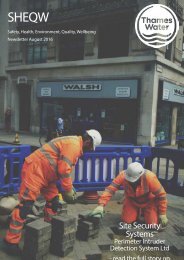SHEQWs Newsletter November
You also want an ePaper? Increase the reach of your titles
YUMPU automatically turns print PDFs into web optimized ePapers that Google loves.
Incident - Chalk/Calcium Carbonate<br />
Discharge to a Non-Main River<br />
What happened?<br />
• A recent incident on an eight2O<br />
site saw chalky water discharged<br />
into a non-main river (usually<br />
a dry ditch) situated parallel to<br />
the site. The site had set up the<br />
dewatering system three weeks<br />
previously, had a permit to pump<br />
formalising their monitoring<br />
regime and had undertaken the<br />
activity without any problems<br />
until the morning of the incident.<br />
• Following a complaint received<br />
downstream of the site, the<br />
discharge point was checked and<br />
cloudy water was observed being<br />
released into the environment.<br />
At this point all pumping and<br />
dewatering activities were<br />
immediately stopped.<br />
Why did it happen?<br />
There are 2 potential reasons for<br />
the incident which may have acted<br />
individually or in combination:<br />
• The blinding activity undertaken<br />
on the day of the incident may<br />
have impacted on the alkalinity<br />
of the water in the vicinity of the<br />
shaft. A change in alkalinity can<br />
turn water containing calcium<br />
carbonate cloudy. This water was<br />
then drawn up by the dewatering<br />
sump and into the silt trap.<br />
• A change to a more chalk like<br />
ground strata meant that the<br />
equipment being used was<br />
no longer appropriate for the<br />
dewatering activity.<br />
What were the potential<br />
consequences of this<br />
incident?<br />
Water contaminated with suspended<br />
solids such as chalk can be extremely<br />
damaging if allowed to enter<br />
watercourses. Damage can include:-<br />
• Blocking fish gills leading to<br />
death<br />
• Deoxygenating water killing any<br />
reliant organism<br />
• Smothering aquatic plants<br />
• Transport of toxins into an<br />
ecosystem<br />
• Alteration of a rivers chemistry<br />
e.g. pH which can have an impact<br />
on certain species<br />
• Water pollution events such<br />
as this account for many<br />
prosecutions under the Water<br />
Resources Act each year and can<br />
result in unlimited fines and even<br />
prison sentences. Prosecutions<br />
can also have a significant impact<br />
on the reputation of our business<br />
and can also impact on future<br />
work winning.<br />
What can we do to prevent it from happening again?<br />
• Where dewatering to surface water, a watercourse precondition checklist must be completed and the site<br />
must ensure that the wider environment is assessed within this (i.e. flowrates of the watercourse prior to<br />
discharge, water quality samples from both up and downstream and photographs of all monitoring locations)<br />
• All dewatering operations must be fully risk assessed using the necessary templates<br />
• Ensure that the site has established what water and potential sediment will need to be monitored in terms of<br />
quantity, quality etc.<br />
• Changes in the environment , including a variation of ground strata, should lead to a reassessment of the risk<br />
• Dewatering operations require the use of the eight2O Permit to Pump process to be followed.<br />
• Dewatering and pumping operations must be appropriately monitored with records kept including<br />
photographic evidence of all samples taken.<br />
• IEMP control plans must be site specific to the activity being undertaken and identify water management<br />
equipment specification, monitoring and maintenance requirements etc.. Relevant activity specific<br />
information such as monitoring should also be included within the RAMS.<br />
• When dewatering to surface water, monitoring must be undertaken at locations downstream as well as at the<br />
initial discharge point.<br />
Page 6 | <strong>November</strong> 2016 SHEW <strong>Newsletter</strong><br />
SHEW <strong>Newsletter</strong><br />
<strong>November</strong> 2016 | Page 7
















